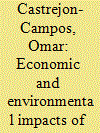| Srl | Item |
| 1 |
ID:
186495


|
|
|
|
|
| Summary/Abstract |
Learning curve theory has been adopted for investigating the relationship between technological learning and technology cost developments. The aim of this paper is to explore the impacts of public investment in clean energy research, development, and demonstration (RD&D) on future technology cost developments by using a two-factor learning curve approach. Learning-by-deploying and learning-by-researching were chosen as the main sources of learning. The focus is on onshore wind and solar photovoltaics in the United States of America. By using publicly available data, we estimated learning-by-deploying rates of 31.4% and 27.6%; and learning-by-researching rates of 2.3% and 4.7% for onshore wind and solar PV, respectively. By adopting a logistic curve approach, an additional $1322 and $819 mil. were forecast to be spent by 2050 in RD&D for onshore wind and solar PV, respectively. We explored the plausible long-term effects of diverse RD&D investment scenarios on electricity generation and greenhouse gas (GHG) emissions using a system dynamics model. The findings reveal that public investment in RD&D for clean energy technologies may play a key role in the pace of capital cost reductions and technology diffusion. However, relatively little long-term effects of RD&D efforts alone were found on market dynamics and GHG emissions.
|
|
|
|
|
|
|
|
|
|
|
|
|
|
|
|
| 2 |
ID:
132608


|
|
|
|
|
| Publication |
2014.
|
| Summary/Abstract |
Using an agent-based modeling approach we study the temporal dynamics of consumer opinions regarding switching to dynamic electricity tariffs and the actual decisions to switch. We assume that the decision to switch is based on the unanimity of ? past opinions. The resulting model offers a hypothetical, yet plausible explanation of why there is such a big discrepancy between consumer opinions, as measured by market surveys, and the actual participation in pilot programs and the adoption of dynamic tariffs. We argue that due to the high indifference level in today×s retail electricity markets, customer opinions are very unstable and change frequently. The conducted simulation study shows that reducing the indifference level can result in narrowing the intention-behavior gap. A similar effect can be achieved by decreasing the decision time that a consumer takes to make a decision.
|
|
|
|
|
|
|
|
|
|
|
|
|
|
|
|